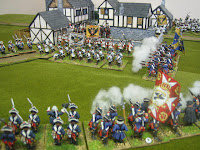

Background.
On the 14th April 1471 Queen Margaret and her son Edward Prince of Wales landed at Weymouth with a small army of invasion. Their aim was the reinstatement of Henry VI and the Lancastrian Regime. On the same day Edward IV went one step towards preventing those ambitions; he defeated and killed the Earl of Warwick, styled “The Kingmaker”, at the Battle of Barnet.
On learning of Warwick’s defeat the Queen marched her army to Exeter, the heart of pro-Lancastrian south west England, to make plans and recruit. Eleven days after landing her army had swollen to about 5000 men. On the 25th they marched north to unite with the Tudors in Wales.
Meanwhile, Edward IV had been informed of the new threat rising in the west and began to array another army at Windsor. On the 24th he started out towards the west country.
Whilst the bulk of the Queen’s forces marched towards Bath, two much smaller forces were dispatched east to give the impression they were marching on London. The ruse failed. On 1st May the Lancastrians arrived at Bristol. On the same day the Yorkists arrived at Chipping Sodbury. On 2nd May the Lancastrian army marched out of Bristol and the Yorkists, convinced battle was imminent, deployed to meet them on Sodbury Hill. This time he was wrong. The Lancastrians slipped by and stole a day’s march up the Severn Valley.
As soon as Edward realised what had happened he dispatched messengers to Richard Beauchamp, the governor of Gloucester instructing him to bar the city’s gates and deny the enemy the bridge over the Severn. On 3rd May, after a march of 36 miles in 24 hours, the Queen’s army arrived at Gloucester. Beauchamp did his duty and denied the Queen’s army access across the river. Losing the whole day in failed negotiations, the Lancastrians had no choice now but to march onto Tewkesbury where a ferry was available.
The army arrived that evening, tired out, and made camp. It would take the whole of the next day for the army to cross over the Severn. As darkness fell, scouts reported Edward IV was at Treddington only 3 miles away. The crossing would be impossible in the face of the enemy. All choice was removed. The Lancastrians had been hunted down and forced to do battle on the morrow.






Scenario Notes

Terrain.
The Gastons were an area broken by “evil lanes” an “so many hedges, trees and bushes”.
These make all movement difficult (half speed) and provide some cover [type II]. All terrain within this area is “virtual” and may be moved around to ease the movement of figures.
The Vineyards were probably the property of the Abbey. I have assumed that they are what they say they are, they are consequently type III.
I have classed Coln Brook as type III. Stop at contact and one move to cross.



Lancastrian Player:
Basic deck with the addition of one infantry and one cavalry Move in the Open card. Draw 5 cards from the characterisation [morale] deck replacing any stratagems, OR, draw 4 cards from the deck and automatically count the following stratagem as having been drawn.
“…by certain paths and ways therefore afore purveyed, and to the Kings party unknown, he [Somerset] departed out of the field, past the lane, and came into a fair place, or close, even afore the king [Edward IV] where he was embattled, and from the hill that was in one of the closes, he set right fiercely upon the end [flank of the Yorkist’s battle line] of the King’s battle.”
The Lancastrians add a Stratagem to their card deck. On its appearance the Lancastrian player may place the following troops on top, or behind [river side], of the hill in any facing:
Providing that units of Somerset’s command have not moved: His unit of men-at-arms and / or a Bill and bow unit made up of stands from other units in his command.
Providing that units of Wenlock’s command have not moved: A Bill and bow unit made up of stands from other units in his command.



Yorkist Player:
Basic deck with the addition of one infantry and one cavalry Move in the Open card. Draw 6 cards from the characterisation [morale] deck replacing any stratagems, OR, draw 5 cards from the deck and automatically count the following stratagem as having been drawn.
Before the battle got under way Edward IV, fearing an ambush, ordered his prickers to scout out the ‘Park’ which lay 400 yards away. The Yorkist player may repeat these orders and place a unit of light cavalry off table. Add a Stratagem card to the deck. They may only arrive after the first melee has been fought, from the direction of the Park, on the Stratagem card's appearance. If they are not deployed off table they must form the rear of Edward's battle.
















































